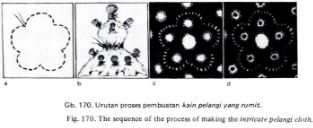Pelangi voorbereiden
Tie-dye is een uitsparingstechniek voor het verven van textiel, waarbij delen van de stof opgeknoopt worden met een touwtje en dan één of meerdere keren geverfd worden. Eenmaal losgeknoopt laat het een uniek patroon zien, vaak levendig en kleurrijk. Hoe je het touwtje vast knoopt, bepaalt het patroon – en er zijn veel patronen om een simpel stuk stof mee te transformeren.
“The Javanese name for this kind of goods is “planggi”.
Deze manier van verven dankt haar traditionele naam aan de vele kleuren die de stof krijgt - Pelangi -, of regenboogdoek. In Midden-Java wordt het soms Plangi genoemd, van het Javaanse woord plong dat ‘leeg’ betekent. Dit verwijst naar de delen van de stof die tijdens het proces ongeverfd blijven. In de Javaanse traditie werd wit niet gezien als een aparte kleur maar als iets onstoffelijks – een leegte die tot leven gebracht kon worden met levendige kleuren. Een Pelangi wordt meerdere malen geverfd: het is een doek met veel kleuren en een verscheidenheid aan betekenisvolle patronen. Dus laten we de tien nummers volgen die Driessen gaf aan de illustraties en laten we leren hoe in 10 stappen een Pelangi gemaakt wordt!
Stap 1
De zijde wordt gevouwen en er worden kleine patroontjes op de platte lagen genaaid met een sterke plantaardige draad. Deze kleine bloemvormpjes zijn een van de meer complexe ontwerpen voor de traditionele tie-dye.


](https://micrio.thingsthattalk.net/lCTzm/views/max/183x128.s.jpg)